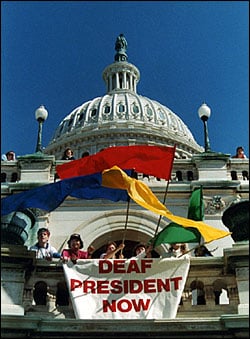
Deaf President Now (DPN)
- by Start ASL
- No Comments
A big event that occurred in Deaf history was the Deaf President Now (DPN) movement.

DPN was a huge protest at Gallaudet University that started in March of 1988. The students, faculty, and staff at the university as well as the national deaf community were united and fought together for one clear goal…
To finally have a deaf person run the world’s only deaf university–Gallaudet.
When it came to election time, the University’s Board of Trustees chose a hearing candidate, Elizabeth A. Zinser, as Gallaudet’s seventh president. After six hearing presidents, the staff, faculty, students, and alumni of Gallaudet were ready for a deaf president.
However, the Board of Trustees chose a hearing candidate over two qualified deaf finalists instead.
Everyone was stunned. Including me, when I learned about it. They immediately demanded that a deaf president replace Zinser. A protest broke out. The protestors shut down the entire campus during this movement. They blocked campus entrances; no one could enter the school. Many were arrested and put in prison. These protestors made national headlines. As a united group, the deaf were going to do everything possible until they got their way.
Zinser finally resigned after a week of these protests. I. King Jordan, a faculty member of Gallaudet, became the first deaf president of the University.
The DPN movement unified deaf people of every age and background. They collectively fought until they were heard. They triumphed and proved that they don’t have to let society take control of their culture.
That is why this was the first event I learned about.
For more in-depth information about the protests in 1988, visit this DPN section of the Gallaudet University website. That part of the Gallaudet website is the most informational piece I have ever seen about DPN.
The Best DPN Book
Deaf President Now!: The 1988 Revolution at Gallaudet University
Understanding the Deaf President Now movement is critical to understanding Deaf Culture. To read more about DPN and gain a more in-depth understanding about what happened that year, we highly recommend this book.
Please note that when you choose to purchase through the external links on this website (in many but not all cases) we will receive a referral commission. However, this commission does not influence the information we provide in this site. We always give honest opinions and reviews to share our findings, beliefs, and/or experiences. You can view our full disclosure on this page.
“Introduction.” DPN Anniversary. Gallaudet.edu. 22 Aug. 2008.
Deaf President Now Articles by Students
My Four Favorites
by Rozelyn Wisen | June 19, 2017
I have been thinking about this assignment for awhile now and contemplating who I felt was the most interesting and made the most impact on deaf culture. At first I was interested in writing about Abbe Charles-Michel de l’Epee and his contribution to deaf education and the developement of Sign Language, but as I was reading more about Deaf history I was drawn to William Stokoe and his contribution to deaf culture, deaf education and ASL. Yet as I studied further it was four others that have made a significant advancement in deaf culture and education.
So I haven’t chosen one but four individuals. These were the four students that led the Deaf President Now, the 1988 student led protest at Gallaudet University 9 “the world’s leading liberal arts university for the deaf” in Washington, DC. (DJSC pg 649)
Gallaudet was first established in 1864 and up until 1988 was led by hearing presidents and in 1988 the Board of Trustees was made up of 17 hearing individuals and only 4 deaf individuals with the chair of the board was Jane Bassett Spilman, an hearing individual. When the staff and students heard that the president was resigning they felt that this was the time for a significant change, it was time for a deaf President to run this university for the Deaf. Three candidates were put forward by the board, I. King Jordan who was then Gallaudet’s Dean of the College of Arts and Sciences and was deaf; Harvey Corson, who was also deaf, was the superintendent at the Louisiana School of the deaf and Elisabeth Zinser, the assistant chancellor at the University of North Carolina, who was not only not deaf but did not even know ASL.
When the student body discovered that the board had decided on Zinser as the new president great anger and frustration and they wanted to know the reason behind Zinser’s selection. Four students at this time rose to the surface to be the spokes people for the students of Gallaudet. The outgoing Student Body President, Tim Rarus, who had 4 generations of deaf family members. Before attending Gallaudet he had graduated from Arizona School for the Deaf and Blind in Tuscan, Arizona; the incoming Student Body President, Greg Hlibok, who was deaf from birth; Jerry Covell, who was deaf, born to deaf parents and had attended Washington State School for the Deaf in Vancouver, and who had unsuccessfully ran against Greg Hlibok for Student Body President but was still tagged as the protesting students “spiritual leader” because of his passion; and the fourth was Hlibok’s running mate, Bridgetta Bourne (I could not find as much info on her background)
These four became known as The Big Four and they led the protests with determination, intelligence and perseverance and after locking down the school and making sure they were heard, they put forth the demands of the DPN protest which were 1. Zinser’s resignation and appointment of a deaf president; 2. the IMMEDIATE resignation of Jane Bassett Spilman as chair of the Board of Trustees; 3. restructuring of the Board of Trustees to a 51% deaf majority; and finally 4. no reprisal against any staff or students involved with the protest. Zinser at first refused to resign as did Spilaman. However after a very well run protest and the support of the public and politicians on day 5 of the protest Zinser stepped down, and on Day 8 of the protest Phil Bravin, a deaf member of the Board of Trustees, and Spilman hosted a press conference to say that Spilman had resigned and Bravin was the new chair and that every one of the demands had been met and they announced the appointment of I. King Jordan as the first deaf President of Galludet University.
The Big Four had led a successful Civil Rights protest and had changed the course of history for deaf education and the public perception of just what the deaf could accomplish as a united front. It is no surprise that these four went on to have very successful careers, Rarus who graduated with a B.A. in Government and his first job was on Capitol Hill working for Senator John McCain; Hlibok graduated with a B.A. in Government and went on to study law fulfilling his dream of becoming a lawyer and he currently serves as chief of Disability Rights Office in Consumer and Government Affairs Bureau at the Federal Communications Commission; Covell graduated with a B.A. in American Government and he is currently the coordinator of the Interpreter Preperation Program at MacMurray College in Jacksonville, Illinois; and Bourne was also a government major and earned her masters at Gallaudet, she currently community education coordinator at the California Shool for the Deaf.
Sources: https://en.wikipedia.org/wiki/Deaf_President_Now
https://nvdatabase.swarthmore.edu/content/gallaudet-university-students-protest-deaf-university-president-deaf-president-now-1988
Deaf President Now
by Karen Kotovsky | July 5, 2017
For this writing assignment I chose not to write about just one significant person from Deaf History, but many. I am thoroughly intrigued by these brave/strong students and faculty at Gallaudet University who stood up for right in the DPN – Deaf President Now protest. I have a tendency to be one who “fights” for the under dog, the oppressed, the blue collar hard working, shoved aside people. I was and still am a strong union backer. I know DPN is not a union organization but, it fought just as union workers have fought for decades. These students, faculty and others stood up, marched and spoke out for what was and is right!
Gallaudet University was started by and run by Hearing individuals for over 120 years. There is no one saying these people were bad, or didn’t do great things for the University. No, DPN was saying it time, it’s time for the University, and the country to understand (as started in Step 2 Start ASL) “deafness is not a disability, but a quality that brings deaf people together as a community and a culture that can function on its own.” Hearing people can stop thinking and feeling like they need to “take care of us” – Paternalistic views.
That week during DPN was compared to the civil rights movement. I conquer – The Deaf community was and is still at times an oppressed community.
If I am to actually need to name, names for this paper – The four students who eventually emerged as leaders of the protest were: Bridgetta Bourne, Jerry Covell, Greg Hlibok, and Tim Rarus. These names and other information I found on the Gallaudet University web site History issues page. Amen to these four for standing tall in the face of adversity!
DEAF POWER!!
During the week of DPN (March 6 – March 13, 1988) the protesters were strong in their conviction by traveling to and from the University to the Capital. They used cars, buses and their own bodies to block the campus. They gave up their Spring Break to make sure things were carried out to the end! The Board stood firm as well, not backing down on their decision.
The board had 4 final candidates for the new President of the University, one hearing and 3 deaf. They chose the 1 hearing candidate. Jane Spilman the Board of Trustee President underhandedly in a “backdoor” fashion made a earlier than expected press release announcement, instead of making the announcement herself. The students and faculty which had been so adamantly working for a Deaf President were now in disbelief and angry. They were angry at both the decision and the backhanded way it was announced. Gary Olsen the President of NAD – National Association of the Deaf stepped up. He had the groups go to Spilman and ask for an explanation. Spilman only agreed to meet with Tim Rarus who had been on the search committee. It was stated (Spilman denied she ever said it though) that Spilman said in this meeting, “Deaf people are not able to function in a hearing world.” This just went to show everyone how out of touch Spilman and the other Board members were with deaf people. This just stirred everyone up even more. This also made the protester even more organized in everything they did day to day for the next week. This went from being a local issue to a national one. Members of the protest leadership were interviewed by Ted Koppel and also appeared on Good Morning America. The supports grew to include Congressmen, Marlee Matlin and Jesse Jackson. The leaders of the protest presented the Board with 4 demands. At first the Board refused all of them. By Day 6 (March 11, 1988) the Board realized their mistake. Their new President Elisabeth Zinser resigned. That was only 1 of the 4 demands. The students vowed to stay at the University through Spring Break to make sure the remaining 3 demands were met. On Day 8 – March 13, 1988 All 4 demands had been met!!! Dr. I. King Jordan was named the Eighth President of Gallaudet University – The First Deaf President! It was front page news in The Washington Post and other newspapers across the country and the world. Deaf people REALLY can do anything – except hear.
I look forward to continuing my understanding of the events of DPN by reading your suggested book: Deaf President Now! The 1988 Revolution at Gallaudet University.
Additional Source: https://www.gallaudet.edu/about/history-and-traditions/deaf-president-now
Deaf President Now
by Novalie Bulin (Mansfield TX) | March 8, 2013
My favorite among the Deaf Community are those young adults who stood their ground and demanded a Deaf President Now.
It took great courage and strength of character to stand up for themselves and the students of the future. They finally got the attention of society that the Deaf have rights and would no longer tolerate being treated as handicapped.
How incredulous to have a hearing president for a deaf university. How can one group of people tell another I know what’s best for you. Unless you are part of that group, you can never fully understand what their lives are completely like. One can sympathize or imagine but never truly know.
The time had come for real understanding and equality for the Deaf Community and the DPN movement helped to bring that to light. Because of the national attention given to this protest, the Deaf Community was able to unite. Adults and children throughout this country could finally see they were not alone and they had rights equal to any other American citizen.
It’s hard to fathom that in the then 20th Century, an entire group of people could still be discriminated against either intentionally or out of ignorance but thanks to the students, faculty and staff at Gallaudet University, the Deaf Community was given a voice that all could hear.
Gallaudet and Deaf President Now
by Janiece (Tennessee) | June 4, 2013
My favorite people are those deaf individuals that stood up at Gallaudet and demanded a Deaf president. They risked their freedom, their future, and their reputation for what they believed in. I feel it is inspiring to learn about a group of people who pull together to do the hard, but right thing and hold on through whatever comes. I am still learning about that moment in time at Gallaudet, so I don’t know all the details. I can only imagine how a university of Deaf individuals would naturally want a university president that understands more clearly what it is like to walk in their steps and face their shared struggles. I was surprised to learn this was the chain of events for Gallaudet. I assumed incorrectly that those helping to start the university would have made it a priority from the beginning to have Deaf individuals leading the university. This article has sparked my curiosity to learn more and understand more clearly how Gallaudet and the Deaf culture continues to change. The moment of people coming together for a moral and true cause is a legacy that I want my daughter to learn from and see in me and so many others that have the heart and faith to stand up when our fear wants us to sit down.










